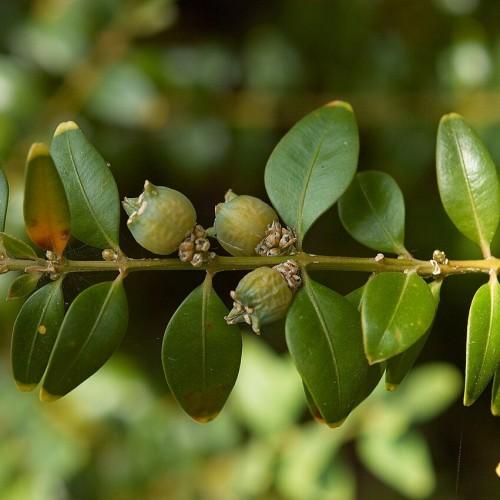
boxwood
Buxus sempervirens 'Flora Place'
Cycle:
Perennial
Watering:
Average
Hardiness Zone:
5 - 8
Flowers:
Flowers In Spring
Sun:
Deep shade, Filtered shade, Full sun only if soil kept moist, Part sun/part shade
Soil:
Alkaline, Well-drained
Fruits:
Fruits In Summer Ready In Fall
Leaf:
Yes
Growth Rate:
Moderate
Maintenance:
Moderate
Care Level:
Medium
watering
For Boxwood (Buxus sempervirens 'Flora Place'), proper watering is essential for healthy growth. Water should be supplied evenly and regularly throughout the season, with a light soak once a week. This will keep the roots cool and moist, but not overly saturated or dry. During hot, dry weather, a light watering every 3-4 days may be necessary. Avoid over-watering as this can lead to root rot. In cooler months, only water when the top 3-4 inches of soil feel dry. In late winter and early spring, water lightly, about once every 10-14 days.
sunlight
Boxwood (Buxus sempervirens 'Flora Place') is best grown in full sun to partial shade. When grown in full sun, the boxwood plant will thrive and produce strong foliage growth. However, in areas with extreme summer heat, plants may need some afternoon shade for protection from the heat. Aim for around 6-8 hours of direct, unfiltered sunlight each day, preferably morning sun, for optimal plant growth and health.
pruning
Boxwood (Buxus sempervirens 'Flora Place') should be pruned in early spring, typically around March or April. It is important to avoid pruning too often, as this can result in a loss of density and can even ruin the natural shape of the plant. Prune only to remove dead, weak, diseased or crossing branches, and to thin and shape for desired look. Make sure to leave room for growth on the top and sides, as this species does not tolerate severe pruning. Shear the sides and top lightly once in the early spring. This species can also be pruned lightly during the summer to help maintain shape.
FAQ
Is Boxwood a popular landscape plant?
Yes, Boxwood is a popular landscape plant, due to its versatility in design, hardiness in cold temperatures, attractive foliage and its ability to be pruned into a variety of shapes. It makes an attractive year-round hedge, foundation plant or edging and, if left unpruned, can be grown as a small tree or shrub. Boxwoods can be planted either in the sun or partial shade and are a great addition to gardens of any size.
Are Boxwoods evergreen?
Yes, boxwoods are evergreen. They have deep green foliage and remain an attractive evergreen tree year-round, allowing for a versatile way to add color and structure to outdoor spaces. Boxwoods are also extremely easy to grow, making them a great choice for novice gardeners. Additionally, boxwoods are relatively low maintenance and can handle some light pruning if needed.
Can Boxwoods be trimmed into shapes?
Yes, boxwoods can be trimmed into shapes. With regular maintenance and occasional pruning, they can be cut and shaped into hedges, topiary, round forms and other creative patterns. Pruning them regularly also ensures that they remain healthy and look their best. It is important to trim them with the right tools and techniques in order to keep them healthy, while also achieving the desired shape.
Could Boxwoods be used as a hedge plant?
Yes, boxwoods can be used as a hedge plant. They are low-maintenance, evergreen shrubs that can be trimmed to create uniform hedges or shaped into topiary. Boxwoods are also resistant to disease and can tolerate both full sun and partial shade. They are ideal for small to medium hedges and make an attractive backdrop for annual and perennial flowers.
Should Boxwoods be planted in full sun or shade?
It depends on the variety of boxwood you have. Some varieties, such as English boxwood, are best planted in full sun for optimal growth and form. However, other varieties such as American and Korean boxwood do better in partial shade due to the more intense heat of full sun. In areas with long, hot summers and mild winters, provide some shade protection to prevent over-heating and drying out, especially during the hottest times of day.
